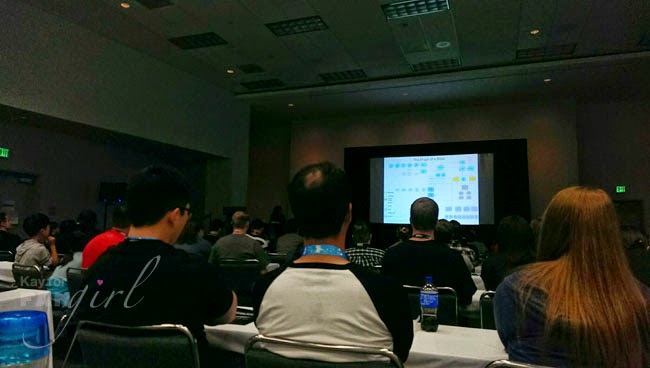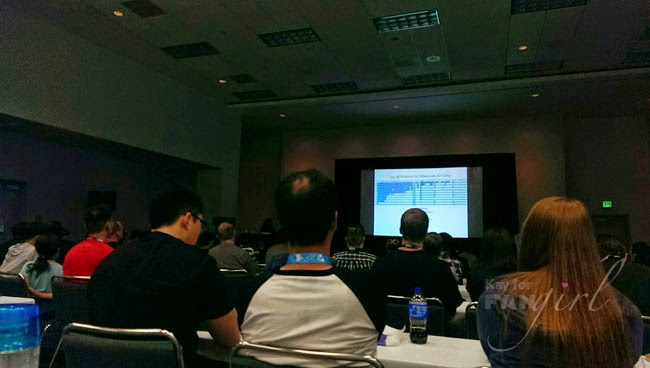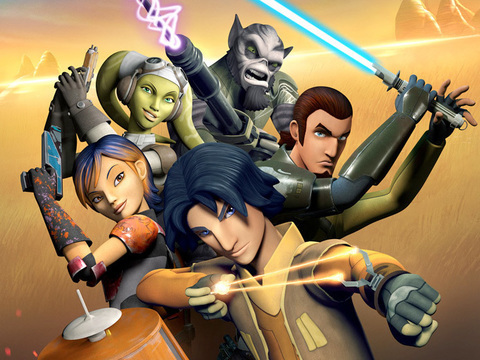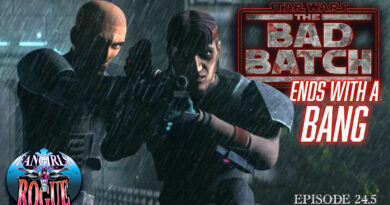Star Wars Celebration Anaheim: Ideas Become Reality: Star Wars Production Class
When the schedule for Star Wars Celebration Anaheim came out, one of the University-track panels I immediately got excited about was “Ideas Become Reality: Star Wars Production Class”. When it comes to your favorite TV shows or movies, you probably know who stars in it, you may even know who directed it and often who wrote it too, but fans tend to not recognize producers quite as widely. Tricia, BJ, and I talked briefly about producing when we focused on Kathleen Kennedy in episode three of Hyperspace Theories. In it I admired Kennedy’s ability to get things done–a very useful trait when you’re running a production.
What does it mean to be a “producer,” and what does it mean to produce for Lucasfilm? Athena Portillo, Line Producer for Star Wars Rebels and Liz Marshall, Production Manager for Star Wars Rebels, will dive in to the specific roles of production staff, cover skills and traits needed to do the job, and give tips and insider tricks how to deal with the challenges and the ever–changing landscape -Ideas Become Reality: Star Wars Production Class listing

Held on Saturday afternoon, the Star Wars Production panel was run by Athena Portillo and Liz Marshall who both work in a producing role on Star Wars Rebels. The room was filled to capacity and these women hit the ground running to cover a lot of info in their allotted time. There was no moderator and it very quickly became apparent there was no need for one. Portillo and Marshall had a plan and they were going to hit all their points and get it done. Liz Marshall in particular promised to show the audience a lot of “exciting spreadsheets” and they were no joke. Making a show like Rebels takes a lot of planning, scheduling, and managing. While bigger ideas like the overarching story and determining the look and feel of the show are important, there are a ton of small pieces that need to come together.
Then there’s the little fact they shared that it takes two weeks to produce one minute of Rebels. They went on to explain that means it takes about two years to produce 22 episodes. So they refer to the master scheduling of production as “mind tetris”. If anything in the schedule needs to change, there’s a whole series of other pieces it affects.
For example, later in the panel they told the story of the sequence with Darth Vader and the Inquisitor at the beginning of “Spark of Rebellion” when the episode aired as part of the special showing of Rebels on the ABC network. That first episode/”movie of the week” was all but in the can when notes came out of a meeting in September of 2014 that the scene should be added. While both women agree that the addition helps tell the story better–the “children of the Force” concept gives viewers a reason to wonder and care about Ezra from his first appearance–it was no simple task to stick that scene in.
Because the schedule is so tight, the various departments involved in animatics and modeling and so forth had already moved on to the next episodes so they all had to stop what they were doing to go back to make this new scene. Plus they now needed to schedule a recording session with James Earl Jones as Darth Vader and Jason Isaacs as the Inquisitor, when both men had their own busy schedules in addition to neither of them being in the same time zone as each other or the production staff. There was no room for error either. Soon Variety was publishing an article about Vader’s appearance on the show. And if you watched the ABC airing in October, you know the team did indeed make their deadline.
While certain groups do their part for the show and then move on to the next episode, Marshall and Portillo are involved in pretty much the entire process. Their involvement starts with the writers conference. First a premise is decided on; then an outline is made, and then the first, second, and final drafts are written. Each episode is broken down into production milestones. The script alone has six milestones. After all that a script moves on to storyboarding and design. Asset building can begin after that. (Assets can be sets, props, and characters.)

Now consider that once a set of milestones are completed on an episode, that team is working on the next one. But a producer is keeping tabs on the episode that’s now moved into the design phase or the asset building phase or the animatics phase all while tracking another that’s being written or storyboarded or what have you. And while scheduling and checking in on everyone to make sure they’re getting their part done as agreed upon and on time is a large part of a producer’s job on Rebels, there’s still more to it. Essentially very cool project management, there’s also the budget to consider. Portillo and Marshall shared that they’re part of the process that bids out asset production to overseas teams too. Yes, yet another team for them to keep tabs on. Once a team is selected and the assets are made, all the assets have to be accuracy checked to make sure everything looks as ordered.
Their budget work also means that producers are creative problem-solvers. Sometimes the story team wants to have a huge action sequence that will require a lot of in-scene players. The producers have to make sure they keep in mind that a costly scene will require smaller scenes with existing assets down the line.
When too many new assets are needed for a scene, the producers might figure out a way to keep the cost down while still getting a scene as close to as it was originally envisioned by suggesting something like recoloring an existing asset. Although they didn’t get into it, if you’ve watched Rebels, you’ve probably noticed that there are several Imperial Officers with their caps pulled down over their eyes. That makes them a reusable asset and saves up money for other character features or appearances.

One of the scenes they showed during the panel was when Tarkin came to question the Lothal Imperials in the first season. Portillo and Marshall pointed out that even though it looks like a full bay, there are actually only six characters in that scene. If you look closely, you’ll notice none of the stormtroopers are moving. They’re part of the background (and way cheaper than animating a platoon). Marshall noted that actually there are never more than six characters in any shot of any Rebels episode. This helps focus the visuals of the story as well so the audience knows who to pay attention to when.
It all comes down to what the panelists knowingly referred to as CYA tracking. Take a minute to consider all the things these two women are constantly watching, checking on, and considering and you should be able to figure out what that stands for. They revealed the tools of their trade to be Excel, email, and a database called Zam (named after Zam Wesell).

Is your head spinning yet? Between all the factors they’re considering at any given time and the Vader scene story, I found myself stressing out on Portillo and Marshall’s behalf by the time they started winding down their talk. Athena Portillo had just recently been sick and she talked about how her refusal to take it easy lead to her getting in trouble – not only with her initial illness getting worse, but also with Dave Filoni and Kiri Hart when they found out that Liz was bringing Athena’s work to her and meeting with her on a regular basis even though she was supposed to be on bed rest. There is no doubt that these two women not only have a great working relationship, but that they are absolutely dedicated to keeping the Rebels ship running full steam-ahead.
The class closed out with an audience Q&A where Marshall and Portillo’s knowledge and resourcefulness continued to be on full display. They commented on the look of the show being a blend of Ralph McQuarrie’s concept art with Hayao Miyazaki’s animation style. When asked about Star Wars writing, they revealed the show’s lead writer Henry Gilroy was in the audience. Gilroy shared that George Lucas told him that in order to write Star Wars, don’t read or watch Star Wars. George advised him to study history, to bring in new things. And as promised, Portillo and Marshall answered questions from people interested in getting into producing, emphasizing the importance of internships and experience because a degree alone won’t let you hit the ground running.
It was very cool to get the opportunity to hear more from some of the women at Lucasfilm who are most definitely getting stuff done.
Liz Marshall has worked at Lucasfilm Animation since 2009, starting her career as an intern on Star Wars: The Clone Wars. Originally from Maine, Marshall received her animation degree from Emerson College in Boston. She currently resides in the Bay Area, and continues her career at Lucasfilm as the Production Manager on Star Wars: Rebels. – from her Celebration Anaheim bio
Athena Yvette Portillo was an Emmy Award-winning line producer for Star Wars: The Clone Wars and is now the line producer on Star Wars: Rebels.
A part of the Star Wars universe since 1996, Portillo was granted an internship at Lucas Licensing during a time when the original trilogy Special Editions, as well as The Phantom Menace were underway in product development. During this period she contributed articles to Lucasfilm’s official fan magazine Star Wars Insider.
Portillo moved to Industrial Light & Magic to pursue her interest in Visual Effects. She then went on to Tippett Studio where she continued her production experience on such films as Blade II, Matrix Revolutions and Constantine to name a few. Portillo has just entered her nineteenth year in the entertainment industry and couldn’t be any more excited to continue to be a part of the Star Wars legacy. – from her Celebration Anaheim bio
Author’s Note: Athena Portillo’s portrait for her Celebration Anaheim special guest listing was her dressed as Princess Leia (as if I didn’t think she was amazing enough).
Update: If you’re looking for more with Athena and Liz, check out Andi Gutierrez’s starwars.com Cantina interview from Celebration.
Kay grew up wanting to be an astronaut. After seeing Star Wars, she wanted to be Princess Leia, Han Solo, and an astronaut. You may have seen her at Star Wars Celebration Anaheim cosplaying as Rey from The Force Awakens, being inspired by all the impressive women working for Lucasfilm, or getting emotional because she was having too much fun. A voice actor, photographer, and artist who also consults in communications and marketing, Kay spends the little bit of free time she has reading, reviewing, and, of course, making pew pew noises. She would pick up more jobs, hobbies, and fitness routines if she was a Time Lord. You can follow her on Twitter.
- Review: Doctor Aphra, An Audiobook Original (Star Wars) - July 26, 2020
- Review: Bonds of Brass by Emily Skrutskie - April 7, 2020
- Review: The Art of The Rise of Skywalker - March 31, 2020











Fascinating read! I’ve read similar articles about other shows and it’s quite striking to know exactly how much work goes into making the shows happen. Also, it makes me happy to know how dedicated everyone is to making the show work. I know there will always be doubters about the direction of Star Wars, but at least those involved in its future are invested in it.
Thanks! I knew it was a lot of work but I don’t think I’d ever stopped to consider just how much is in motion on an animated show at any given time. And well said on those involved in the future of it. It’s so cool to hear how excited they are about the work they’re doing.